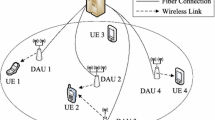Abstract
This paper introduces a C-RAN scenario which is overlapping covered with the macrocell, residential microcells, office microcells under different activeness. Due to the large scare-fading in the urban environment, the signal to interference and noise ratio (SINR) between some offices and the family micro base stations are too small to care. Therefore, some interference between micro base stations and user are not considerable. In order to improve the energy efficiency in the CoMP process, this paper presents selective beamforming with channel matrix sparse algorithm. This algorithm greatly reduces the complexity of matrix inversion calculation during beamforming and improves the energy efficiency of the system. Simulation results show that the proposed algorithm can effectively reduce the energy consumption of the baseband and improve the energy efficiency of the system.
Access this chapter
Tax calculation will be finalised at checkout
Purchases are for personal use only
Similar content being viewed by others
References
Boccardi, F., Huang, H.: Zero-forcing precoding for the MIMO broadcast channel under per-antenna power constraints. In: IEEE 7th Workshop on Signal Processing Advances in Wireless Communications, SPAWC 2006, 2–5 July 2006, pp. 1–5 (2006)
Gao, F., Zhang, R., Liang, Y.-C.: Optimal channel estimation and training design for two-way relay networks. IEEE Trans. Commun. 57(10), 3024–3033 (2009)
Cui, T., Gao, F., Ho, T., Nallanathan, A.: Distributed space-time coding for two-way wireless relay networks. IEEE Trans. Sig. Process. 57(2), 658–671 (2009)
Auer, G., et al.: D2.3: energy efficiency analysis of the reference systems, areas of improvements and target breakdown. INFSO-ICT-247733 Earth (Energy Aware Radio and NeTwork TecHnologies), Technical report, November 2010
Simeone, O., Maeder, A., Peng, M., Sahin, O., Yu, W.: Cloud radio access network: virtualizing wireless access for dense heterogeneous systems. J. Commun. Netw. 18(2), 135–149 (2016)
An energy-efficient Implementation of C-RAN into HetNet. In: IEEE Vehicular Technology Conference, 2014 VTC-Fall, Vancouver (2014)
Abbes, Y., Najeh, S., Besbes, H.: Tractable framework for modeling and analyzing joint CoMP transmission and eICIC technology in two-tier heterogeneous cellular networks. In: 2016 International Symposium on Signal, Image, Video and Communications (ISIVC)
Gao, F., Cui, T., Nallanathan, A.: On channel estimation and optimal training design for amplify and forward relay network. IEEE Trans. Wirel. Commun. 7(5), 1907–1916 (2008)
Auer, G., Blume, O., Giannini, V., et al.: D2.3: energy efficiency analysis of the reference systems, areas of improvements and target breakdown. INFSO-ICT-247733 Earth (Energy Aware Radio and NeTwork TecHnologies), Technical report (2012)
Jia, M., Liu, X., Gu, X., Guo, Q.: Joint cooperative spectrum sensing and channel selection optimization for satellite communication systems based on cognitive radio. Int. J. Satell. Commun. Netw. 35(2), 139–150 (2017)
Acknowledgment
This work was supported by the Open Research Fund of State Key Laboratory of Space-Ground Integrated Information Technology under grant No. 2015_SGIIT_KFJJ_TX_02 and the National Science Foundations of China (No. 61671183).
Author information
Authors and Affiliations
Corresponding author
Editor information
Editors and Affiliations
Rights and permissions
Copyright information
© 2019 Springer Nature Singapore Pte Ltd.
About this paper
Cite this paper
Zhang, X., Liu, X., Wang, H., Liu, Z., Jia, M. (2019). A Resource Allocation Scheme with Excellent Energy Efficiency Based on the Channel Matrix Sparse. In: Liang, Q., Mu, J., Jia, M., Wang, W., Feng, X., Zhang, B. (eds) Communications, Signal Processing, and Systems. CSPS 2017. Lecture Notes in Electrical Engineering, vol 463. Springer, Singapore. https://doi.org/10.1007/978-981-10-6571-2_325
Download citation
DOI: https://doi.org/10.1007/978-981-10-6571-2_325
Published:
Publisher Name: Springer, Singapore
Print ISBN: 978-981-10-6570-5
Online ISBN: 978-981-10-6571-2
eBook Packages: EngineeringEngineering (R0)




